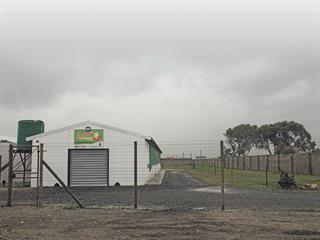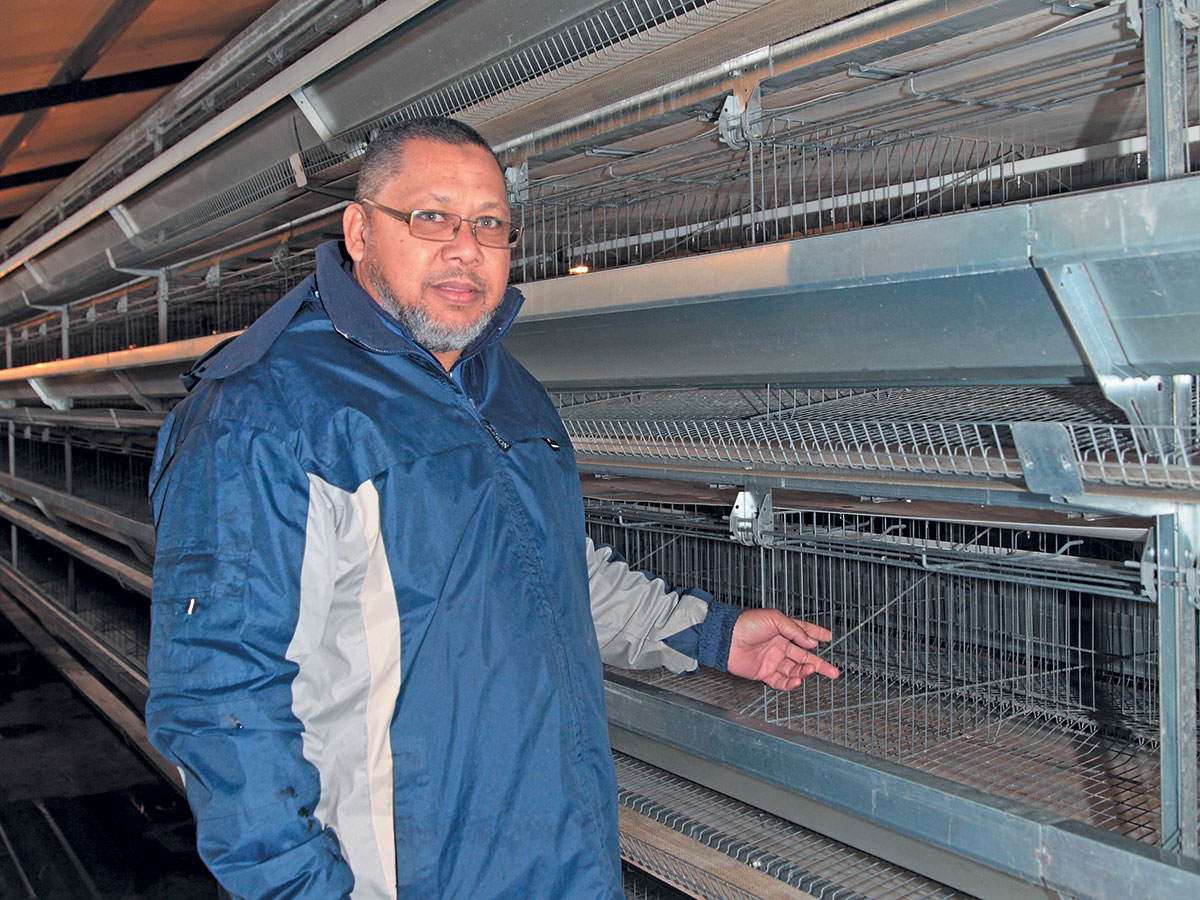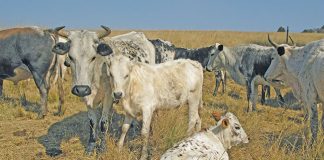
It is well known that disease presents one of the greatest threats to a poultry production operation. “Chickens are probably some of the most fragile animals you can farm.
They get exposed to a little wind and next thing you know, they’ve contracted some lethal respiratory disease. The best and most economical way to reduce this risk is through the implementation of sound biosecurity measures,” says Agmat Brinkhuis, a layer poultry farmer from Philippi on the Cape Flats and chairperson of the South African Poultry Association.
Agmat started his farming operation with 20 layer hens, hoping to supply his household with eggs. The birds produced more than the household could consume, however, so he started selling the additional eggs to other family members. The business grew along with demand, until Agmat decided to expand production to 5 000 layers.

Agmat Brinkhuis points out the wire floors in the coops. These enable manure to drop onto a conveyer belt, which removes it from the chicken house.
“According to the law, an environmental impact assessment is needed when a farmer wants to produce 5 000 or more birds,” he explains. For Agmat, this was the first step in introducing a formal biosecurity programme.
When undertaking an environmental impact assessment, the proposed production area is evaluated to determine whether it is suitable. Various factors are taken into account, such as the location and the potential impact of production on water and other natural resources. Consent also has to be obtained from neighbouring farmers.
“The assessment is expensive, so we did it with funding from the Western Cape Department of Agriculture. It’s also very time-consuming and took two years before the expansion was approved,” Agmat says.
Farmers have to submit a business plan detailing information such as the size of the business, type of production (eggs or meat), waste management programme, marketing strategy, target market, transportation, type of housing and housing design, among others.
“When you write your business plan, don’t think of what is realistically possible now, but where you would like the business to go. When we started farming on our 1,4ha plot, it was more land than we thought we could ever need. Now it’s too small for us,” he says.
While the environmental impact assessment may have been cumbersome and involved a great deal of work, Agmat says it was a valuable experience, which helped him become more aware of the risks involved in a poultry business. It also helped him prepare for future expansion.
He advises prospective poultry farmers to consult with other producers and make use of the available municipal and governmental services to devise practical and effective solutions to potential problems.
Production method
Farmers also need to determine the production system they want to use from the outset. Agmat wanted to introduce caged birds for egg production, as there is a major problem with theft in Philippi.
“To me, it boils down to whether you want to farm eggs or chickens. I farm eggs, with the birds simply being the machines that have to be kept running to achieve this goal. In general, free-range birds are more resilient than birds kept in chicken houses, probably because they are less stressed. These birds nevertheless run a greater risk of contracting diseases from external factors, such as other bird species,” he says.
The latter is the greatest disease threat that Agmat has to deal with. “We live next to a vlei, so there are many birds, ranging from flamingos to wild geese, posing a potential health risk to my chickens. Producing free-range chicken here would not have been a wise idea,” he says. The windows of the poultry houses are covered with mesh wire to prevent wild birds from entering the production area.
Agmat buys his hens at point of lay when they are 19 weeks old. The birds have been vaccinated against all the major diseases prevalent in his production area and each bird comes with a ‘birth certificate’, stating vaccinations received, birth weight and other details. In addition, an entire production programme accompanies each bird, specifying how much feed it should receive per day, the amount of light it should be exposed to daily, and weight targets that should be reached at specific intervals.
“You have to buy healthy birds from a reputable source. If you buy birds from an unreliable source and there’s something wrong with them, you have no one to blame but yourself,” he says.
Agmat has two poultry houses with a combined production potential for 15 000 birds. However, only 10 000 birds are kept per season, as he prefers not to keep them in crowded conditions, and therefore has six instead of nine birds per coop. Layers are kept for a year, as production generally starts to decline thereafter. During this period, each bird produces on average 365 eggs – one egg per day. According to Agmat, there are a few farmers who keep the birds for longer, but to him this does not make economic sense.
Spent hens are sold to vendors who sell the birds in the informal market. Layers are bought for R65/hen at point of lay and sold as spent hens at R20/hen to R35/hen, depending on market demand.
Informal vendors do not pose a great risk of introducing disease, according to Agmat, as all the birds are sold at about the same time. Poultry houses are then thoroughly cleaned and sterilised, and kept vacant for two weeks after sterilisation, before a new group of birds is introduced.
All the maintenance is undertaken during this period as well, as such an opportunity will present itself again only in another year when the next batch of spent birds is sold.
Feed control
While the price of eggs has remained stable at between 80c and R1 an egg, feed prices have increased from about R1 800/t to about R4 700/t over the past eight years, Agmat explains.
The birds on the farm are fed a specially formulated, high-protein diet, which Agmat says should also be bought from a reputable supplier. He keeps samples of the feed purchased each week, so that he can refer back to a sample if any difficulties arise. Growth problems can be attributed to various factors, but feed samples can be analysed to determine whether a problem was due to poor feed formulation or mycotoxins, he says.
Water is another potential source of contamination. Agmat uses municipal water for his birds; if water is extracted from wells or rivers it has to be tested regularly to monitor whether it is safe for consumption. Agmat points out that high sodium or mineral levels can also have a negative impact on the watering system in the chicken houses, causing nipples to clog up. He also advises using galvanised steel to prevent metal from rusting.
Pest control
Flies and rodents pose a major challenge to poultry production. Agmat says that rats are attracted to the high-protein feed, but often also attack and kill the birds. They also present a serious risk of disease.
To protect birds from rodents, Agmat regularly checks for any openings in the walls and ensures that doors are strengthened to stop these pests gaining access. In addition, traps are set and monitored weekly to further reduce this risk. A 0,5m-wide cement pathway has also been built around each house to make it easier to identify intrusions.
According to Agmat, there are various ways of controlling fly populations, ranging from adhesive ribbons to pesticides. He recommends that farmers consult municipal health inspectors for advice in this regard.
Waste management
Waste is removed from the poultry houses daily to reduce fly infestation and the risk of respiratory problems as a result of high ammonia levels. The coops’ wire floors enable the manure to fall through onto a conveyor belt that removes the manure from the chicken houses. The manure is used as fertiliser for the 19ha of vegetables which Agmat produces at a different location.
Access to the birds is restricted to as few people as possible, and the poultry houses are therefore enclosed by a fence as well as a wall.
“We have only two workers who are allowed inside the poultry houses,” he says.These workers have to shower and change into workwear – which is washed and disinfected daily – before entering the production area. Foot baths are also located at the entrances to the chicken houses to disinfect work shoes.
To ensure strict biosecurity controls, the drivers of feed delivery trucks are not allowed to disembark, and the trucks are sprayed with disinfectant, while the farm’s own workers offload the feed.
“I learnt the importance of this the hard way. We once lost 3 500 birds due to a salmonella outbreak that was introduced via an outsider,” he says.
“Ensuring sound biosecurity may sound like a lot of hard work, but if you do it correctly all the time, it becomes second-nature. Introducing these habits is also easier when one understands the reasons for them. So it’s important that workers are informed and understand the risks of a biosecurity breach.
Phone Agmat Brinkhuis on 083 943 1959.













